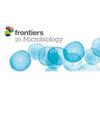Responses of diazotrophic network structure and community diversity to alfalfa-maize intercropping are soil property-dependent
IF 4
2区 生物学
Q2 MICROBIOLOGY
引用次数: 0
Abstract
IntroductionIntercropping and soil properties both affect soil diazotrophic communities. However, the specific effects that alfalfa-maize intercropping has on diazotrophic networks and community diversity under different soil properties remain unclear.MethodsIn this study, we investigated the soil diazotrophic communities of two crop systems, alfalfa monoculture (AA) and alfalfa-maize intercropping (A/M), in two sites with similar climates but different soil properties (poor vs. average).Results and discussionThe diazotrophic network complexity and community diversity were higher at the site with poor soil than at the site with average soil (重氮营养网络结构和群落多样性对紫花苜蓿-玉米间作的响应取决于土壤特性
引言间作和土壤特性都会影响土壤重氮营养群落。方法在本研究中,我们调查了在气候相似但土壤性质不同(贫瘠与一般)的两个地点,紫花苜蓿单作(AA)和紫花苜蓿-玉米间作(A/M)两种作物系统的土壤重氮群落。结果与讨论贫瘠土壤地块的重氮营养网络复杂性和群落多样性高于普通土壤地块(p &p;lt;0.05)。土壤贫瘠和土壤一般的地点之间的群落结构也有很大差异(p&p;lt; 0.05)。这种差异主要是由于两地土壤氮、磷和有机碳含量的不同造成的。在土壤贫瘠的地点,A/M 系统的重氮营养体多样性、网络复杂性和重氮营养体之间的竞争均低于 AA 系统(p &p;lt;0.05),这是因为在土壤贫瘠的条件下,间作加剧了土壤对磷的限制。结论我们的研究结果表明,苜蓿-玉米间作对重氮营养群落的影响取决于土壤性质。
本文章由计算机程序翻译,如有差异,请以英文原文为准。
求助全文
约1分钟内获得全文
求助全文
来源期刊

Frontiers in Microbiology
MICROBIOLOGY-
CiteScore
7.70
自引率
9.60%
发文量
4837
审稿时长
14 weeks
期刊介绍:
Frontiers in Microbiology is a leading journal in its field, publishing rigorously peer-reviewed research across the entire spectrum of microbiology. Field Chief Editor Martin G. Klotz at Washington State University is supported by an outstanding Editorial Board of international researchers. This multidisciplinary open-access journal is at the forefront of disseminating and communicating scientific knowledge and impactful discoveries to researchers, academics, clinicians and the public worldwide.
 求助内容:
求助内容: 应助结果提醒方式:
应助结果提醒方式:


